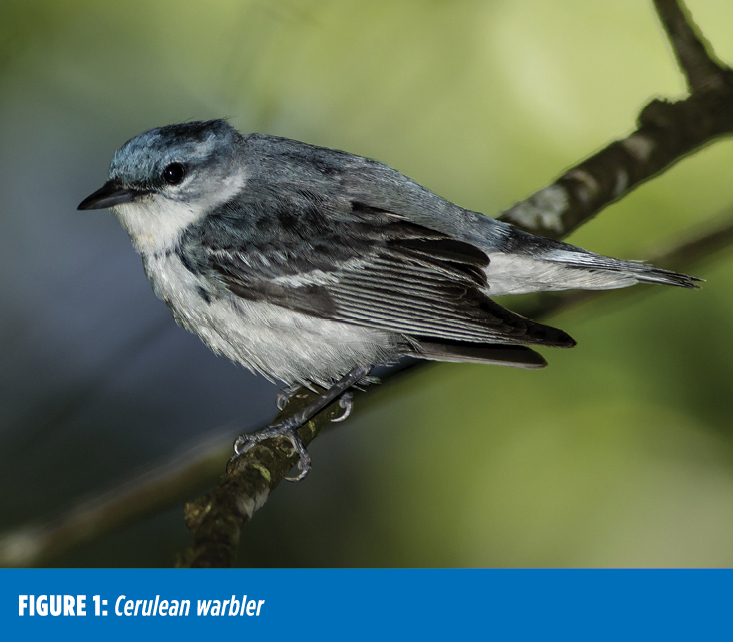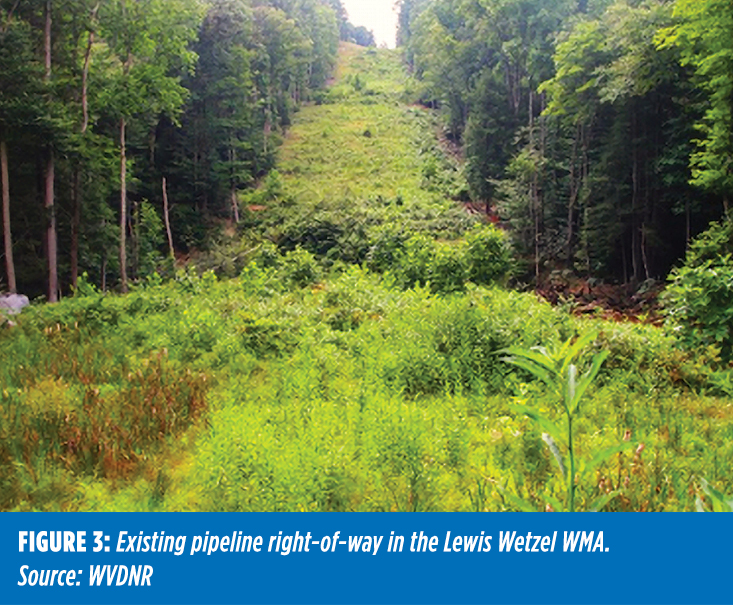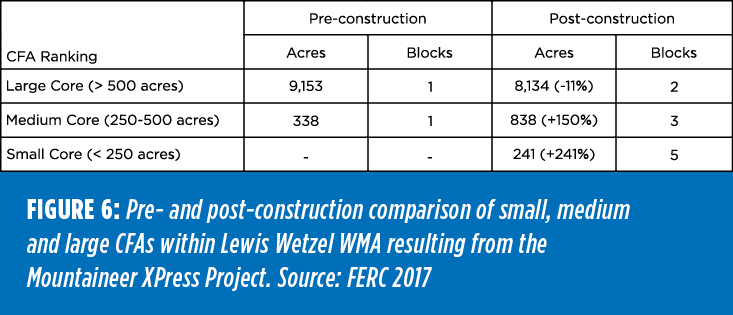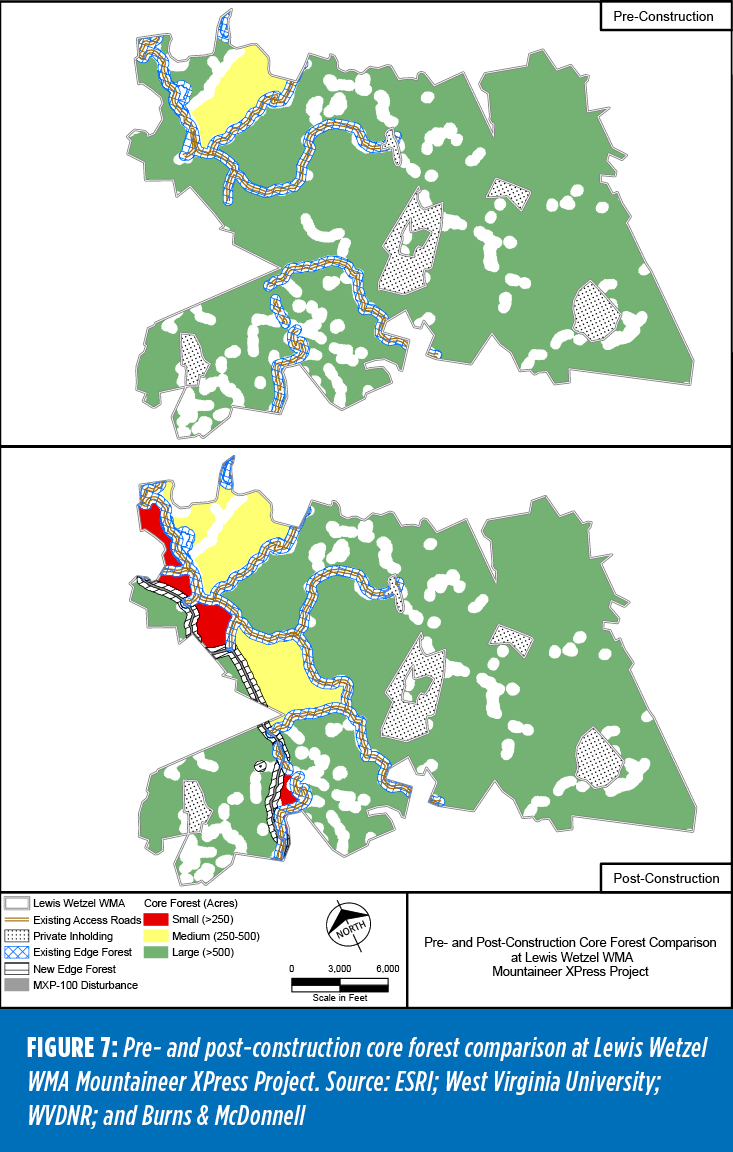The Mountaineer XPress Project (MXP) included a 170-mile-long, 36-inch-diameter greenfield natural gas pipeline that traverses upland forested areas of West Virginia. Sponsored by Columbia Gas Transmission LLC and regulated by the Federal Energy Regulatory Commission (FERC), the MXP is designed to move natural gas from the Utica and Marcellus basins to markets in the Midwest, Northeast, Mid-Atlantic, South and Gulf Coast.
The project is located in an area that has undergone centuries of forest fragmentation. Road and railroad construction from the 1780s through the 1830s was followed by coal mine development during the mid-19th century and, later, crude and natural gas drilling. By the 1920s, timber booms had depleted nearly all virgin timber in the area. Coal fields, mountaintop mining operations, and oil and gas extraction wells dominated the West Virginia landscape throughout the 20th century.
Federal environmental protections require consultation and permitting. In some cases, they impose restrictions or mitigation measures for projects that affect resources such as wetlands, water bodies, farmland, environmental justice communities, threatened and endangered species, or air quality. However, no federal protections are currently in place for interior upland forested areas or for some of the interior forest-dwelling species that depend on these areas. In West Virginia, for example, no state regulations limit forest clearing, and activities such as oil and gas extraction and transportation and transmission operations have a dominant presence in certain landscapes.
Through a cooperative effort, FERC and the West Virginia Division of Natural Resources (WVDNR) developed a method for assessing and quantifying these impacts.
THE ROLE OF INTERIOR FORESTS
Interior forests provide food resources and a valuable breeding habitat for a variety of wildlife species, and they often have greater species richness and ecological integrity than surrounding areas. Clearing or fragmentation can affect feeding and nesting habitat availability and quality for certain species, as well as isolate species populations. Some species require large, unfragmented blocks of habitat, and fragmentation can lead to reduced habitat quality.
While habitat fragmentation can negatively impact habitat specialist species, it can have a positive or neutral effect on habitat generalist species. Utility corridors can create a barrier to wildlife movement for some species and a travel corridor for others. Corridor widths and vegetation characteristics can affect species differently. Abrupt transitions from mature forest to open land often constitute the greatest barriers, while a forest-to-shrub-to-grassland transition can have little to no effect on transiting species.
Interior forests are particularly important habitats for species that are sensitive to forest fragmentation. These habitats deliver an added level of protection to interior forest-dwelling species because of their seclusion from edge effects. Species that are adversely affected by roadways; utility rights-of-way; residential, commercial and industrial developments; or other sources of fragmentation are most affected by the decline of large contiguous tracts of forested areas.
Certain migratory birds, such as the cerulean warbler (Figure 1), are particularly sensitive to the negative effects of fragmentation due to nest predation by raccoons, snakes and corvid species, and would be subject to nest parasites such as brown-headed cowbirds. Noise and light pollution from roads and developments, alterations to existing wind, heat and other climate variables, and the establishment of invasive plant species also can affect species that dwell in interior forests.

In West Virginia, state-owned Wildlife Management Areas provide important habitat for forest interior birds like the cerulean warbler, which breeds in eastern North America and winters in South America. Its habitat includes large tracts of mature deciduous forest with a closed canopy created by many large, tall trees.
West Virginia supports the highest densities of cerulean warblers anywhere in the species’ breeding range. Since 1966, the species has declined at a rate of about 3 percent a year, due in part to loss of its breeding and wintering habitat, as well as habitat fragmentation. It is listed as a Priority 1 species — Species of Greatest Conservation Need — in the West Virginia State Wildlife Action Plan.
ASSESSING MXP PROJECT IMPACTS
Construction of natural gas pipelines and associated infrastructure can result in new, cleared corridors in forested areas. It also can contribute significantly to the cumulative impacts in areas where other projects and actions involve forest clearing.
Clearing or fragmentation creates more edge habitat and smaller forested tracts, which can affect the characteristics and juxtaposition of vegetation communities, including their suitability for some specialist wildlife species. The creation of new corridors and forest edges can alter wind, humidity and solar exposure, which can lead to a change in vegetation species composition and diversity. Forest edges also play a role in ecosystem functions, including the dispersal of plants and wildlife, the spreading of fire, movement of wildlife, and vegetation composition and structure.

The MXP falls within Bird Conservation Region (BCR) 28, where approximately 80 percent of the remaining population of cerulean warbler population breeds (Figure 2). While BCR 28 is over 100 million acres in size, breeding areas for the cerulean warbler have been affected by the clearing of more than half of the area’s historical forests. Suitable breeding habitat for cerulean warblers includes structurally diverse canopies with a large enough forest patch size to reduce the risk of nest parasitism and predation. The minimum isolated forest patch size for detection of the cerulean warbler is 341 acres. Although the cerulean warbler makes use of canopy gaps and can be found using thin forest edges and small perforated areas near narrow roads or rights-of-way, they are less abundant near abrupt forest edges, and in West Virginia have been shown to avoid edges of power lines with rights-of-way that are about 75 feet wide.
The MXP pipeline crosses four such Wildlife Management Areas (WMA) in West Virginia. While most are not considered unique, rare or significant, the Lewis Wetzel WMA is recognized as an Important Bird Area (IBA) for cerulean warbler management. IBAs are sites considered important and necessary for global bird populations’ survival.
While the WVDNR owns, manages and controls surface land at the Lewis Wetzel WMA, mineral rights are largely controlled by private individuals. Numerous natural gas wells and pipelines already are present or cross the area and have contributed to the conversion of interior forest habitat to a patchwork forested mosaic. Existing rights-of-way that bisect the area provide linear shrubland habitat scattered throughout the area (Figure 3).

PROTECTING HABITAT THROUGH PRACTICAL MITIGATION
With the help of the WVDNR and other agencies, FERC conducted a comprehensive environmental review of the project site, as required by the National Environmental Policy Act (NEPA). Section 102 in Title I of NEPA requires federal agencies to incorporate environmental considerations into their planning and decision-making.
Traditionally, FERC categorizes interior forests as forested areas that are more than 300 feet from the influence of forest edges or open habitat. For the MXP, FERC further refined this definition with the help of a data set produced by the Natural Resource Analysis Center at West Virginia University.
This database breaks the interior forest into Core Forest Areas (CFA), each based on the acreage of contiguous habitat with a 100-meter defined edge width. CFAs are further differentiated as patches (small forest fragments), edges (continuous forest periphery), perforated (core forest containing small clearings), small core (less than 250 acres), medium core (250-500 acres) and large core (greater than 500 acres). Figure 4 shows some of the pre-construction CFAs traversed by the MXP that are in proximity to the Lewis Wetzel WFA.

With help from WVDNR staff, FERC used information in the data set to develop mapping that delineated CFA rankings along the MXP pipeline route and proposed access roads. Where new project facilities traversed these areas, conversions were modeled for post-construction acreages. The project’s impact was established by comparing pre- and post-construction CFAs.
The analysis found that MXP construction would create a new, cleared corridor in interior forest areas that would impact the characteristics of vegetation communities, including their suitability for wildlife. Review of CFAs within 10 miles of either side of the MXP indicates that the project would traverse an area comprising approximately 577,583 acres of large CFAs and less than 3,000 acres of small and medium CFAs. The MXP would decrease large CFAs by 3 percent, while creating 21 additional blocks of large CFA. It would also more than triple the amount of medium CFAs, and more than double small CFAs (Figure 5).

The analysis concluded that MXP construction would directly impact about 1,311 acres of primarily large core forest areas. Operation of the MXP would permanently impact about 490 acres. The overall decrease in suitable habitat would be about 2 percent. The MXP also would create forest edge where the pipeline traverses these CFAs.
The MXP traverses the Lewis Wetzel WMA for approximately 5 miles. Consisting primarily of large CFA, this WMA contains an estimated 9,491 acres of suitable habitat for the cerulean warbler. The MXP components within the Lewis Wetzel WMA include a 125-foot-wide pipeline construction corridor along with existing access roads. MXP construction would result in the creation of 8,134 acres of large CFA, 838 acres of medium CFA and 241 acres of small CFA. The total amount of suitable habitat for the cerulean warbler in the Lewis Wetzel WMA in post-construction conditions would be estimated to be 8,972 acres, a decrease of about 5.5 percent (Figures 6 and 7).


The final Environmental Impact Statement (EIS) concluded that the MXP’s impact on upland forest habitat would be significant because of the decrease in large CFA acreage along the pipeline route. The pipeline construction’s impact on the cerulean warbler habitat and the existing CFA within 10 miles of the MXP corridor also would be significant.
Using the FERC analysis, WVDNR developed and applied a process for assessing the impacts on CFAs. Using Visual Habitat Equivalency Analysis software, WVDNR developed habitat replacement ratios for the pipeline’s permanent right-of-way, construction right-of-way, and a 300-foot buffer on both sides of the right-of-way based on a model of forest recovery.
Habitat replacement would require the following ratios: 2.5:1 for impacts to 50-foot-wide permanent rights-of-way and 1.8:1 for the additional 75-foot temporary construction rights-of-way. A 300-foot buffer on each side of the rights-of-way was assessed a 0.5:1 ratio.
An additional assessment for forest cores less than 250 acres and perforated cores was prorated at 50 percent, resulting in ratios of 1.25:1, 0.9:1, and 0.25:1 for permanent, temporary and buffer impacts. Mitigation and compensation for any lands owned or managed by the state were determined separately for each property.
Replacement habitat developed by the WVDNR included a requirement for a core forest component. Priority was given to acquisition of property or conservation easements on properties that are within:
- the WVDNR’s Wildlife Resources Section land acquisition priority area;
- a State Wildlife Action Plan Conservation Focus Area;
- or a high-priority conservation area of one or more land trusts accredited by the Land Trust Alliance.
All acquisitions would be open to perpetual access for wildlife-oriented recreation, including hunting. The WVDNR developed a suitability index to prioritize potential property acquisitions based on landscape integrity, ecological integrity, biodiversity ranks, acres of public land available per hunter, and cerulean warbler density.
FERC issued a final EIS in July 2017, followed by an order in December 2017 granting Columbia Gas Transmission a Certificate of Public Convenience and Necessity to construct and operate the MXP. Included in FERC’s order was a condition requiring project proponents to work with WVDNR on developing practical mitigation measures for the restoration and management of state-owned upland forest areas that would reduce the MXP’s impact on the cerulean warbler habitat.
Construction of the MXP began in January 2018. The MXP utilized a 125-foot-wide temporary right-of way for construction in nonagricultural uplands. In most areas, a 50-foot-wide permanent easement has been retained for operation of the pipeline. The majority of the MXP was placed into service in January 2019, with the remaining segments expected to come online soon thereafter.
Working with the WVDNR, Columbia Gas Transmission volunteered to avoid, minimize and replace habitat for nearly 6,500 acres of CFA. Because there are no federal protections for impacts on upland forested areas, FERC staff did not dictate which mitigation or restoration methods to use. With input from FERC staff, Columbia Gas Transmission and the WVDNR came to an agreement on appropriate mitigation and/or restoration measures.
That agreement called for Columbia Gas Transmission to provide habitat replacement to benefit cerulean warblers and other Species of Greatest Conservation Need in West Virginia. Through implementation of its Multi-Species Habitat Conservation Plan and payments to The Conservation Fund, Columbia Gas Transmission provided funding for the purchase and protection of additional CFAs.
By combining these funds with those from additional pipeline projects and other sources, the WVDNR acquired more than 30,000 acres of additional public lands. Developing a suitability index for CFA replacement and partnering with The Conservation Fund as a fiduciary, the WVDNR has provided for the acquisition and protection of habitat in areas impacted by large-scale pipeline projects.
LESSONS LEARNED
There are currently no federal protections in place to preserve large CFAs or other categories of interior forest. Given the magnitude of oil and gas exploration and distribution projects in West Virginia and the region, a fair, reasonable and consistent evaluation of the pre- and post-construction impacts should be considered in all NEPA documents.
As a cooperating agency, the WVDNR had the opportunity to participate in the NEPA process with access to FERC staff throughout development of the EIS for the MXP. By closely collaborating with WVDNR on local, regional and statewide concerns over CFA losses, FERC staff were able to recommend special conditions in the FERC order. These conditions directed the applicant to work with WVDNR to devise and implement mitigation measures compatible with the restoration and management of state-owned upland forested areas, as well as to reduce impacts on cerulean warbler habitat.
The most common methods of minimizing environmental impacts during the construction of pipelines and other linear features include collocating with existing infrastructure and reducing the width of the construction and permanent operational corridors. Columbia Gas Transmission worked to do both, attempting to collocate and minimize its workspaces where possible. Because of the steep terrain traversed by the MXP, however, industry-approved safe construction practices required a wider working right-of-way.
Other possible mitigation options that could be considered to reduce core forest fragmentation on future projects include placing conservation easements on large CFAs, funding statewide stewardship programs, assessing in-lieu fee payments to state-run programs that specialize in the CFA preservation, and purchasing or donating CFAs to the state for conservation.
DISCLAIMER: ANY VIEWS EXPRESSED HEREIN ARE THE AUTHORS’, AND NOT NECESSARILY THAT OF FERC, THE COMMISSIONERS, OR THE FEDERAL GOVERNMENT.